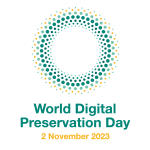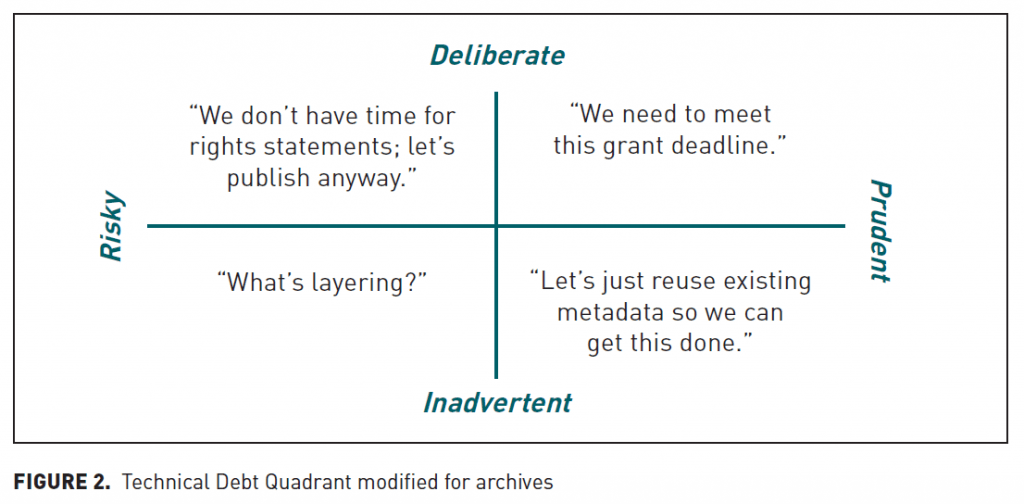 So it has been awhile since my last Reading w/Dan; I had not realized how long it had been. Between the fact I was tackling the book, Digital preservation in libraries: preparing for a sustainable future, attending conferences, going on a long-awaited vacation and well, regular everyday work, all of the sudden it is not the middle of summer, but almost Thanksgiving. In this edition, I will be discussing the aforementioned book edited by Jeremy Myntti and Jessalyn Zoom for ALA Editions in 2019.
So it has been awhile since my last Reading w/Dan; I had not realized how long it had been. Between the fact I was tackling the book, Digital preservation in libraries: preparing for a sustainable future, attending conferences, going on a long-awaited vacation and well, regular everyday work, all of the sudden it is not the middle of summer, but almost Thanksgiving. In this edition, I will be discussing the aforementioned book edited by Jeremy Myntti and Jessalyn Zoom for ALA Editions in 2019.
Divided into six parts and eighteen chapters, Digital preservation in libraries addresses various digital preservation topics through analysis and case studies. It provides insight into:
- the history of and theories for digital preservation
- frameworks, strategies and systems for conducting digital preservation
- case studies at individual institutions
- case studies for the digital preservation of specific material types
- collaborative efforts for digital preservation
- copyright concerns for digital preservation
As with any compilation of essays, some stand out more than others, and I would like to spotlight the ones that resonated most with me. For anyone who feels they need a primer in digital preservation, I would suggest they read the two chapters of Part I that address the history and theory of digital preservation. Erin Baucom’s “A brief history of digital preservation” provides a brisk brief overview of the trajectory of digital preservation efforts, providing highlights of key current organizations and initiatives. Ironically, it includes mention of the DPN (Digital Preservation Network), which ceased to exist shortly before publication of the book. Where Baucom establishes a straightforward history of digital preservation efforts, Ross Spencer’s “Digital preservation as a thought experiment” provides an excellent approach to making the concepts of digital preservation accessible to all through various thought exercises.
In moving from theory to establishing frameworks and strategies, Christine Madsen and Megan Hurst provide some keen insight in “Digital preservation policy and strategy: where do I start?” Digital preservation efforts for an organization must be tailored to the local conditions and resources; as such I found the following two quotes from this essay particularly perceptive:
“The goal of this framework is not to provide hard-and-fast rules for making decisions about what to preserve, but instead to provide a heuristic foundation for structuring organizational thinking and for gaining a better understanding of how to embed digital preservation practices and mindset into an organization.”
“As with any other strategic endeavor, it is best to start with a basic plan that focuses first on understanding the context: 1. What does your organization want to accomplish? 2. What is the mission of your organization? 3. What are the goals of your organization? In other words, begin with a strategy, not with a policy.”
Typically, digital preservation needs to be a collaborative effort, certainly internally, and likely with external resources. At Ohio State, while the digital preservation efforts are spearheaded within the University Libraries IT unit, it is clearly a collaborative process that involves our special collections units, as well as those that provide preservation, digitization and metadata services. In addressing collaboration, Edith Halvarsson, et al, in “Could collaborative research between two major libraries help consolidate digital preservation and break the “project cycle”?” note the following:
“…the authors found that digital preservation policy was viewed in isolation from other policies.”
“At both institutions, policy is viewed as an end-goal in itself and it tends to become static, outdated, and not adequately communicated to staff. Rather, the staff often regard policy as inefficient, since they do not appreciate that policy requires a framework and institutional buy-in to become a working document.”
“…policies are active documents that require frameworks and well-accepted ownership across all levels of the organization.”
They speak to the notion that digital preservation is not a singular effort, but one that should be infused into the ethos of the entire organization. Further, they developed “…a skills audit toolkit [that] was designed and implemented in year one [of their project]. The framework lists over 100 digital preservation skills for executives, managers, and practitioners.” Such an audit is an important step in understanding what competencies an organization has and what they may need. To that end I would suggest reviewing the newly minted DPC Competency Audit Toolkit developed by the Digital Preservation Coalition.
Finally, I would like to draw attention to Chip German and Kara M. McClurken’s essay, “In medias res: an examination of work in progress at the Academic Preservation Trust (APTrust) consortium.” There were two passages that particularly piqued my interest. First, the authors note, “If every donor of relevant materials who gave money for processing/supplies also gave money to a digital-preservation storage endowment, we would move closer to funding those needs.” Too often, things digital because of their “invisible” nature of life in cyberspace, appear to need no resources, and can be magically preserved for free. We forget that we spend enormous sums on preserving our paper-based and analog items, constructing million-dollar storage facilities, for which we then have to provide utilities and maintenance on an ongoing basis. Further, these facilities have to be staffed for storage, retrieval and other assistance. We have to ask our organizations:
- Why do we not approach digital preservation from a similar sustainable business model?
- Why do we continue to fund the bulk of our positions that are solely analog, and not consider more flexible, hybrid positions?
Maybe the problem is the “D” word itself? “Digital” seems exotic, but I would suggest if more folks got some hands-on experience, they would find they would have an affinity for the work and could develop new skills. It is the second passage that I feel speaks to this need, “From our perspective, the biggest risk is not that we will choose unwisely when winnowing down candidates for preservation. It is that the human effort needed to select what is likely to be most important in the future will be overwhelmed by accumulating masses of unassessed digital materials.” As our collections grow, and increasingly become digital, we need to transition our workforce.
Digital preservation in libraries: preparing for a sustainable future, is a worthwhile read and can be approached as a whole-book read, or one can pick and choose the essays they may be interested in. However, I would reiterate the importance of, and strongly encourage folks to read, Part I regarding the history and theory of digital preservation.
 Earlier this year, while attending iPRES 2024 in Gent, Belgium, I met a new colleague and friend, Folasade Adepoju with the Public Services Department of the National Library of Nigeria. She has graciously reached out and invited me to participate in Digital Preservation: A Beginner’s Guide. This presentation is in celebration of World Digital Preservation Day.
Earlier this year, while attending iPRES 2024 in Gent, Belgium, I met a new colleague and friend, Folasade Adepoju with the Public Services Department of the National Library of Nigeria. She has graciously reached out and invited me to participate in Digital Preservation: A Beginner’s Guide. This presentation is in celebration of World Digital Preservation Day.










